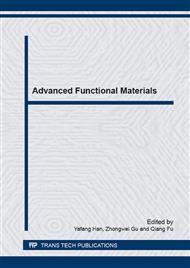p.379
p.385
p.390
p.396
p.401
p.407
p.412
p.424
p.429
Fabrication and Characteristics of Gene-Delivering Nanodevices Based on Au-Ag@CS-FA Hybrid Particles
Abstract:
Gene therapy has great potential in offering highly promising treatments for cancer. Polymer-metal hybrid nanoparticles (NPs) are good candidates as gene delivery vehicles due to their unique properties and facile functionalization. The polymer component in hybrid NPs can provide accurate cancer cell targeting and high DNA binding ability while the metallic component can provide imaging functions for the nanodevices. In the present study, hybrid NPs comprising an Au-Ag bimetallic core and a folic acid-chitosan shell (Au-Ag@CS-FA) were fabricated. The structure and relevant properties of Au-Ag@CS-FA NPs were subsequently studied using a variety of techniques,like scanning electron microscope (SEM), Fourier transform infrared spectroscopy (FTIR), transmission electron microscope (TEM) and UV-visible spectra. Their DNA binding ability was also assessed. Results showed that Au-Ag@CS-FA NPs possessed properties that can make them excellent gene delivery vehicles.
Info:
Periodical:
Pages:
401-406
Citation:
Online since:
March 2015
Authors:
Keywords:
Price:
Сopyright:
© 2015 Trans Tech Publications Ltd. All Rights Reserved
Share:
Citation:


